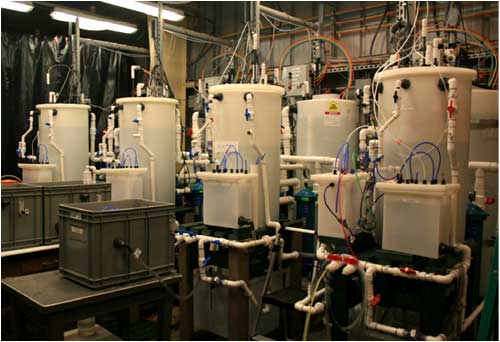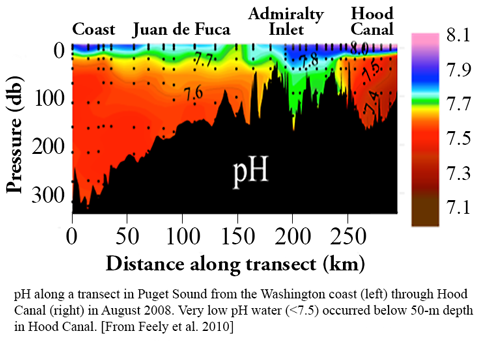Ocean Acidification experiments:

NOAA OA facilitiessWe are working to understand the direct impacts of ocean acidification (OA) on vulnerable early life stages of zooplankton which are critically important in trophic webs of the Pacific Northwest. Because crustaceans (primarily copepods and euphausiids) dominate the zooplankton in most temperate marine ecosystems including Washington State coastal waters and Puget Sound, it is important that we determine how future conditions will alter their population dynamics. Studies of crustacean zooplankton are beginning to reveal important effects of increased pCO2, effects which include large decreases in growth and survival of keystone species such as the Antarctic krill, Euphausia superba, whose egg development is completely inhibited at high, but realistic future bottom-water pCO2 levels (Kawaguchi et al. 2010). But results are mixed, with some taxa showing little or no response to changes in pCO2 (e.g., Kurihara and Ishimatsu 2008, Hauton et al. 2009).
We are currently working with Drs. Paul McElhany and Shallin Busch at the NOAA NWFSC in Seattle and Paul Williams at the the Suquamish Tribe to conduct experiments that will test the effects of OA on several metrics of zooplankton growth and development. Over the next several years, we will be expanding these experiments to include the interactive effects of temperature and oxygen concentrations. The NOAA NWFSC OA facilities are among the best in the world; they were designed in consultation with many of the world's expert chemists including Drs. Richard Feely and Simone Alin at the NOAA PMEL in Seattle.
Field studies

pH levels <7.6 are already common in Puget Sound in summer, so we have a 'natural laboratory' in our backyard where we can study the role of pH in structuring zooplankton growth, survival, and distributions. Large vertical gradients in pH and pCO2 occur across the thermocline in stratified areas such as Puget Sound, so vertical movement of organisms can lead to large variation in the pH conditions they experience. Many zooplankton such as euphausiids (krill), crab larvae, and copepods are among the diel vertical migrants who move from deep water toward the surface every night. It is not known whether these species can sense and avoid areas of low pH or whether they experience the extreme gradient in nature. Many are likely to have adaptations that allow them to tolerate low pH conditions on either short or long time scales. As average pH continues to decline, such adaptations may protect these taxa from deleterious effects of OA. We will be assessing their vertical distributions in relation to water chemistry in Puget Sound to determine the conditions the young zooplankton encounter as they develop. These conditions will then be mimiced in the laboratory.
These studies are being funded by Washington Sea Grant, the University of Washington, and the Federal Fish and Wildlife Service.

